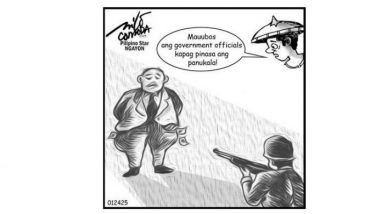People: Still humanity’s biggest problem - DEMAND AND SUPPLY
June 4, 2001 | 12:00am
LOS ANGELES, California – Whoever it was who once declared that he "loves humanity but it is people he can’t stand" just about captured the crux of our dilemma today. The Good Lord has given us dominion over the other creatures and resources of nature, but one wonders if He has foreseen the kind of abuse normally heaped by people on Mother Nature.
Put another way, the reason Alaska has retained as much of its original beauty and richness is because it was largely protected from people coming in droves by its forbidding weather and environment. Alaskans proudly proclaim that it is possible to fit in four states the size of Texas into Alaska’s land area but America’s 49th state barely has a million inhabitants today.
As I reflect on a week’s worth of comfortable travel through the coastal towns of Alaska, I guess the attraction of this strange land where there is sunlight at midnight, lies in its sparse population. Pure oxygen fill up your lungs as the brisk cold wind blows on your face. Sounds funny but 10 minutes of that and I was missing Manila’s polluted air.
Maybe I’ve been trained psychologically not to expect too much and is therefore uncomfortable with the abundance offered by a largely under populated vastness of nature. I also feel shortchanged by its main population center, Anchorage, which you can see in all of one hour. Let’s not even talk of its state capital Juneau, which can only be reached by plane or boat and whose population is overwhelmed every time two or three cruise ships dock at the same time.
But for the Filipinos we have met there, Alaska‘s home. It provides them with a decent living their own country couldn’t give them. I was told that the early Filipino migrants to Alaska were attracted by the jobs in the salmon canning factories. The diaspora of Pinoys started to happen long ago. In Juneau, a third generation Filipina high school student is representing Alaska in a summer youth conference in Europe. She told the local paper she considers herself an Alaskan.
Given Alaska’s vastness and richness in resources and its small population, shouldn’t it encourage more migration from stressed out countries like ours? Maybe not. The secret of Alaska‘s attraction today is precisely because it is a place that has not been devastated by a large population putting pressure on its natural resources. The world needs places like Alaska and we are lucky to have Alaska today.
Filipinos abroad are closely watching the results of the last election. As with us who live at home, they are exasperated with the pre-historic counting process. Here is one e-mail from San Francisco-based Philstar reader, Ben Simpao.
A lot of words have been said and written about how long it is taking to get a tally of the last elections, I got me a solution: Do it the California way.
In California, major elections are held on a working day (Yanks don’t want to lose a day of productivity or days for leisure, Saturday/Sundays off). Voting starts at 7 a.m. till 7 p.m. (to accommodate working folks).
If I remember right, it is held on a Tuesday in November. A few minutes after 7 p.m. voting places are closed. Designated officials from different countries make their rounds to collect ballot boxes, that are in turn, deposited to each country’s EDPCs (electronic data processing center). The ballots are fed into computers.
By eleven in the evening, printouts are posted on the country’s bulletin boards, showing the complete results of the elections for that county. That‘s a span of four hours. Repeat, four hours. Data is also transmitted simultaneously to Sacramento, (the state capital) to the office of the Secretary of State who is (elected official) in charge of election matters for the state.
So the next day’s morning papers would be carrying the results of the elections and the proclaimed winners would be posted in the afternoon papers and the official results the next morning.
The ease in which elections in California is conducted is so boring. It is a matter of simplification. No shooting, no snatching of ballot boxes, no trending, no dagdag bawas, no teachers complaining for their 900 pesos stipend and no Miriam being carted to the nuthouse.
And here’s how it works.
A month before election time, a voter receives mailers on the upcoming elections. There is a booklet on initiatives, the pros and cons of the laws communities or the whole state population would want the state congress to enact. There are the candidate‘s profiles, their agenda, etc. And of course, the place the voter is supposed to vote. Note the important role the post office plays here.
There are no political billboards, no buntings, no banners, no posters, except for measured announcements for a limited number of days. Candidates send their propaganda materials direct to the voters’ residence by mail or they could make their pitch through TV or radio.
The ballot is similar to an IBM card with numbers (appropriate for feeding in the computer). This ballot is inserted and latched in a devise wherein on top of it is a booklet listing the names of the candidates, the propositions, etc.
The voter turns over the pages while punching holes with the corresponding numbers in conjunction with their preference or desired candidate. When the word "end" is reached, the IBM-like card ballot is then unlatched and brought to the desk where the voter drops it into the ballot box in the presence of an elections official and members of the Democratic and Republican parties or any other parties. Tallying on the canvass sheet is eliminated. There is no need for a canvassing board and other unnecessary personnel to handle or mishandle the voting materials.
The official voter’s list identifies the voter, name, address, etc. But to be eligible to vote, an intending voter has to go to the county office to register with proper ID’s. There is no need for seven or eight copies of election returns. Less paper work results in a more efficient way of turning in the election returns the fastest way possible, not a week, two weeks or months.
From Dr. Ernie E., here’s something that explains the root of it all.
A drunk in a bar is unloading on the bartender.
"For 20 long and wonderful years," mused the gent at the bar," my wife and I were deliriously happy."
"Then what happened ," asked the bartender.
"We met."
(Boo Chanco‘s e-mail address bchanco@bayantel.com.ph)
Put another way, the reason Alaska has retained as much of its original beauty and richness is because it was largely protected from people coming in droves by its forbidding weather and environment. Alaskans proudly proclaim that it is possible to fit in four states the size of Texas into Alaska’s land area but America’s 49th state barely has a million inhabitants today.
As I reflect on a week’s worth of comfortable travel through the coastal towns of Alaska, I guess the attraction of this strange land where there is sunlight at midnight, lies in its sparse population. Pure oxygen fill up your lungs as the brisk cold wind blows on your face. Sounds funny but 10 minutes of that and I was missing Manila’s polluted air.
Maybe I’ve been trained psychologically not to expect too much and is therefore uncomfortable with the abundance offered by a largely under populated vastness of nature. I also feel shortchanged by its main population center, Anchorage, which you can see in all of one hour. Let’s not even talk of its state capital Juneau, which can only be reached by plane or boat and whose population is overwhelmed every time two or three cruise ships dock at the same time.
But for the Filipinos we have met there, Alaska‘s home. It provides them with a decent living their own country couldn’t give them. I was told that the early Filipino migrants to Alaska were attracted by the jobs in the salmon canning factories. The diaspora of Pinoys started to happen long ago. In Juneau, a third generation Filipina high school student is representing Alaska in a summer youth conference in Europe. She told the local paper she considers herself an Alaskan.
Given Alaska’s vastness and richness in resources and its small population, shouldn’t it encourage more migration from stressed out countries like ours? Maybe not. The secret of Alaska‘s attraction today is precisely because it is a place that has not been devastated by a large population putting pressure on its natural resources. The world needs places like Alaska and we are lucky to have Alaska today.
A lot of words have been said and written about how long it is taking to get a tally of the last elections, I got me a solution: Do it the California way.
In California, major elections are held on a working day (Yanks don’t want to lose a day of productivity or days for leisure, Saturday/Sundays off). Voting starts at 7 a.m. till 7 p.m. (to accommodate working folks).
If I remember right, it is held on a Tuesday in November. A few minutes after 7 p.m. voting places are closed. Designated officials from different countries make their rounds to collect ballot boxes, that are in turn, deposited to each country’s EDPCs (electronic data processing center). The ballots are fed into computers.
By eleven in the evening, printouts are posted on the country’s bulletin boards, showing the complete results of the elections for that county. That‘s a span of four hours. Repeat, four hours. Data is also transmitted simultaneously to Sacramento, (the state capital) to the office of the Secretary of State who is (elected official) in charge of election matters for the state.
So the next day’s morning papers would be carrying the results of the elections and the proclaimed winners would be posted in the afternoon papers and the official results the next morning.
The ease in which elections in California is conducted is so boring. It is a matter of simplification. No shooting, no snatching of ballot boxes, no trending, no dagdag bawas, no teachers complaining for their 900 pesos stipend and no Miriam being carted to the nuthouse.
And here’s how it works.
A month before election time, a voter receives mailers on the upcoming elections. There is a booklet on initiatives, the pros and cons of the laws communities or the whole state population would want the state congress to enact. There are the candidate‘s profiles, their agenda, etc. And of course, the place the voter is supposed to vote. Note the important role the post office plays here.
There are no political billboards, no buntings, no banners, no posters, except for measured announcements for a limited number of days. Candidates send their propaganda materials direct to the voters’ residence by mail or they could make their pitch through TV or radio.
The ballot is similar to an IBM card with numbers (appropriate for feeding in the computer). This ballot is inserted and latched in a devise wherein on top of it is a booklet listing the names of the candidates, the propositions, etc.
The voter turns over the pages while punching holes with the corresponding numbers in conjunction with their preference or desired candidate. When the word "end" is reached, the IBM-like card ballot is then unlatched and brought to the desk where the voter drops it into the ballot box in the presence of an elections official and members of the Democratic and Republican parties or any other parties. Tallying on the canvass sheet is eliminated. There is no need for a canvassing board and other unnecessary personnel to handle or mishandle the voting materials.
The official voter’s list identifies the voter, name, address, etc. But to be eligible to vote, an intending voter has to go to the county office to register with proper ID’s. There is no need for seven or eight copies of election returns. Less paper work results in a more efficient way of turning in the election returns the fastest way possible, not a week, two weeks or months.
A drunk in a bar is unloading on the bartender.
"For 20 long and wonderful years," mused the gent at the bar," my wife and I were deliriously happy."
"Then what happened ," asked the bartender.
"We met."
(Boo Chanco‘s e-mail address bchanco@bayantel.com.ph)
BrandSpace Articles
<
>
- Latest
- Trending
Trending
Latest


























